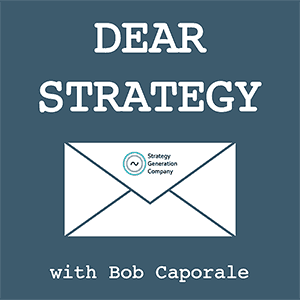Dear Strategy:
“Where is the best place to start when your organization has an extremely broad corporate strategy?”
Well, in my humble opinion, the best place to start is by thanking your company for not placing too many constraints on you.
Having worked through a lot of different product-level strategies with a lot of different product managers, I often hear complaints about corporate strategies being too broad or not specific enough. And my response is always the same: “Why in the world would you want your company to tell you as a product manager exactly what you need to do?”
Strategy development is one of the most fulfilling endeavors that you’ll ever undertake as a product manager (or a marketing manager, or whatever type of manager you are). But I can tell you that the strategy process is no fun at all without allowing for some amount of creativity and, with it, some amount of ownership. Without those two things, your strategy just becomes a set of orders that you’re expected to carry out. Now what fun is that?
Even if that sounds like a bit of an exaggeration with respect to the question at hand, think about a corporate strategy that isn’t overly broad. What might that look like? Well, it’s likely to specify both the overall objectives and overall strategies for each and every product and portfolio that exists inside the company. And then you can say goodbye to creativity and ownership at a product line level.
Instead, what good corporate strategies should consist of are the overarching objectives and initiatives that will apply to most all of a company’s products and portfolios as a collective whole. So you might expect to hear about what major markets your company wants to focus on, or what major technologies should be explored across all product lines, or what overarching values your company wants to embrace, or even what type of businesses your company wants to be in. Yes, all of these things are extremely broad, but, believe it or not, they will narrow down your options just enough so that you can focus your strategies at a product line level without being constricted to exactly what each of those strategies exactly needs to be.
So maybe an example is in order. Let’s say that you have a corporate strategy that focus on three main points:
- Being a first-to-market technology leader
- Focusing on bringing more digital capabilities to your products
- Expanding into underserved global markets
These are three very broad strategies. Now, do any of these strategies tell you exactly what types of products you should be developing, or exactly which technologies you should be implementing, or exactly which countries you should be focusing on? No. That’s where your product strategies will come into play. But without at least this level of overarching guidance, think about how difficult it would be to even know where to start at a product line level. And, worse, think about how many different directions all of your product strategies might end up going in – with no clear message or approach being either implemented or understood in the marketplace.
So where is the best place to start when your organization has a very broad strategy? Well, you start with the corporate strategy because, in fact, that’s exactly what a corporate strategy is supposed to define: the start – not the end. And when a company’s product strategies are all starting from the same place, the endings will have a much better chance of all being aligned as well.
And that is exactly the point.
Listen to the podcast episode
Dear Strategy: Episode 053

###
Bob Caporale is the founder of Strategy Generation Company, the author of Creative Strategy Generation and the host of the Dear Strategy podcast. You can learn more about his work by visiting bobcaporale.com.





